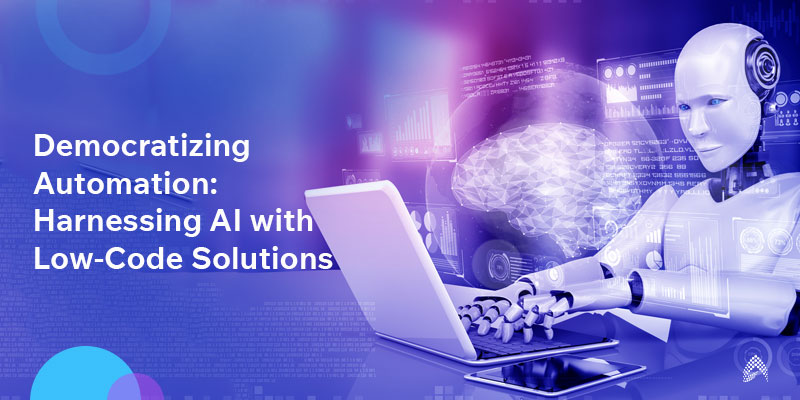Democratizing Automation: Harnessing AI with Low-Code Solutions

Tired of watching competitors speed ahead while your team gets bogged down in manual tasks? We understand. However, traditional automation approaches often require specialized coding skills, lengthy development timelines, and significant costs. These bottlenecks can hold businesses back, limiting their ability to innovate and respond quickly to changing needs. A recent McKinsey survey found that 70% of businesses struggle to scale automation efforts due to skill shortages and technical complexity. If you are frustrated by repetitive tasks that could be automated, wishing you could easily implement advanced analytics or intelligent chatbots without overwhelming your IT department, there’s a better way…
Low-code solutions, empowered by artificial intelligence (AI), offer a revolutionary approach to democratizing automation.
How Low-Code is Breaking Down Business Barriers
Traditional automation has long been the domain of skilled developers fluent in complex programming languages. Low-code platforms are shattering this notion. These solutions leverage visual interfaces, drag-and-drop components, and pre-built modules to simplify the development process. They empower individuals with limited coding experience, often referred to as “citizen developers,” to directly create and manage automated workflows.
This democratization of automation has several profound implications for businesses:
- Agility: Business users closer to the processes they want to automate can make changes, try variations, and implement solutions more quickly.
- Innovation: Low-code environments encourage experimentation. When more people have the tools to automate, new and potentially game-changing ideas are more likely to surface.
- Reduced IT Burden: Low-code automation doesn’t eliminate the need for IT expertise but frees up developers to focus on complex projects, creating a more efficient use of resources across the organization.
The AI Advantage: Smarter Automation with Low-Code
- Pre-built AI Components: Many low-code platforms offer built-in AI capabilities. This includes functionalities like image recognition, natural language processing, or predictive analytics that can be integrated into your workflows using drag-and-drop components.
- Custom AI models: If you have custom-built AI models (developed in-house or through external services), some low-code platforms allow you to connect these models and utilize their predictions or outputs within your automated processes.
Use Case Examples:
- Data Analysis Automation: A low-code platform analyzes large datasets, identifying trends and patterns that would be difficult for a human to detect and improving data-driven insights for decision-making. For instance, a marketing team might use low-code to analyze social media data, revealing customer sentiment patterns and improving campaign targeting for better results.
- Intelligent Chatbots: A low-code platform builds a chatbot that understands natural language, answers routine questions accurately, and hands off more complex customer inquiries to human agents for streamlined support. An example of this would be the HR department deploying a low-code chatbot to answer common employee questions about policies and benefits, freeing up HR staff for more complex tasks.
- Predictive Modeling: Use low-code to create a model that forecasts sales based on historical data and market factors. AI can continually analyze new data, making predictions increasingly accurate over time. Imagine a retailer using low-code to predict sales based on historical data and market trends, allowing them to optimize inventory levels and prevent stockouts.
What Makes Low-Code Work: A Technical Peek
Modular Architecture
Security Features
- Data Encryption: Both when data is stored on the platform (“at rest”) and when it’s being transmitted within the workflow (“in transit”).
- Role-Based Access Controls: This determines who can view, edit, or execute different parts of your automated workflows, promoting secure collaboration.
- Regular Security Audits: Reputable platforms will undergo regular third-party assessments to identify and address potential vulnerabilities.
Customization Possibilities
The Future of Democratized Automation
- Increasingly Sophisticated Solutions: We can expect low-code platforms to incorporate even more advanced AI capabilities, enabling users to automate complex decision-making processes and tap into insights that were previously unattainable.
- Wider Adoption: As low-code tools become more intuitive and powerful, businesses across various industries and sizes will adopt them, making automation accessible to almost any organization.
- A Shift in Skillsets: The rise of democratized automation will elevate the importance of problem-solving, critical thinking, and an understanding of how to harness the power of both AI and low-code within a business context.
Empowering Everyone to Be an Automation Architect
The benefits are undeniable: increased agility, reduced development timelines, and a culture of experimentation that fosters groundbreaking ideas. This democratization of automation empowers “citizen developers” to take ownership of process improvements, alleviating the burden on IT departments and allowing them to focus on more strategic initiatives.
As low-code technology matures and incorporates even more advanced AI capabilities, the possibilities become limitless, like deeper automation, mainstream adoption, and evolving skill sets.
The Next Steps
Alternatively, if you are ready to explore how low-code can transform your business, at Amzur, we’ve witnessed the power of automation firsthand. Let’s connect for a free consultation, and we’ll help you develop a custom low-code automation strategy that unlocks efficiency and drives innovation within your organization.

Technical Architect




